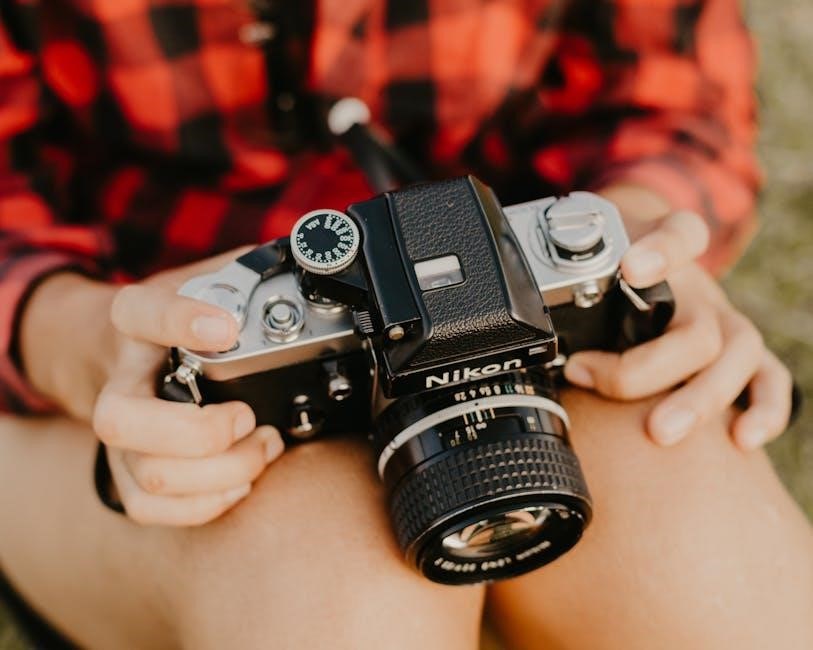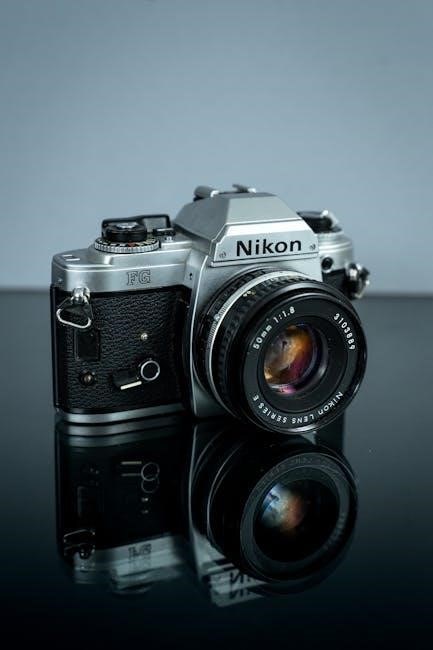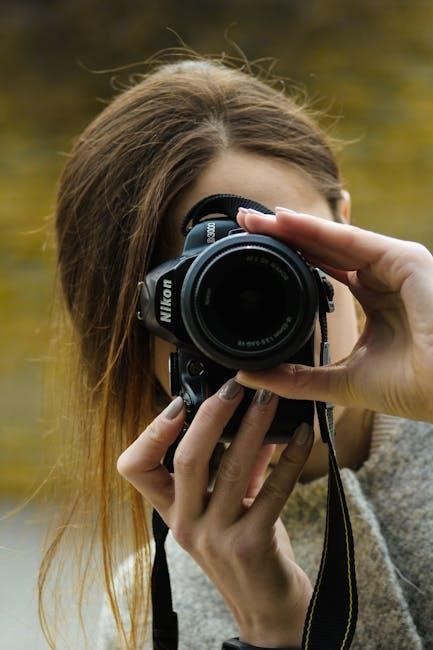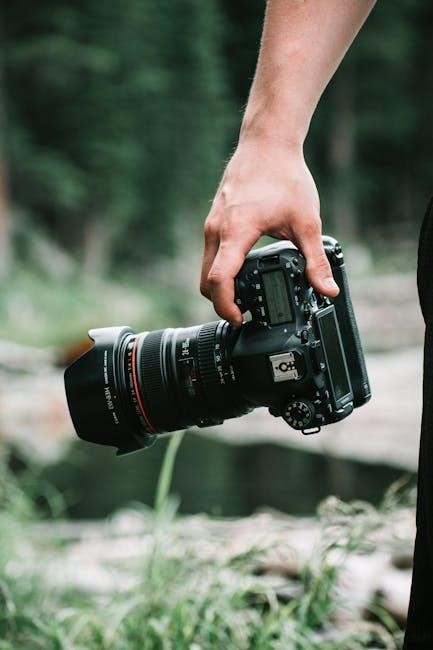The Nikon Z50 manual is your gateway to mastering this versatile mirrorless camera, designed for both beginners and experienced photographers. It guides you through features like autofocus modes, video recording, and custom settings, ensuring you unlock the camera’s full potential effortlessly.
Overview of the Nikon Z50 Camera
The Nikon Z50 is a compact and versatile mirrorless camera designed for photographers seeking high-quality images and ease of use. It features an APS-C sensor, electronic viewfinder, and compatibility with Nikon Z-mount lenses. Ideal for both beginners and enthusiasts, it offers advanced autofocus, video capabilities, and intuitive controls, making it a great tool for capturing stunning photos and videos effortlessly.
Importance of the Nikon Z50 Manual
The Nikon Z50 manual is essential for understanding the camera’s features, configuration, and troubleshooting. It serves as a comprehensive guide for optimizing photography and videography experiences, ensuring users unlock the camera’s full potential. Whether you’re a beginner or an advanced photographer, the manual provides detailed insights to enhance your creativity and technical skills effectively.

Key Features and Specifications
The Nikon Z50 features a 20.9MP APS-C sensor, 4K video recording, and a vari-angle touchscreen. It weighs 395g, supports SD/SDHC/SDXC cards, and uses the Z-mount system, ensuring versatility and performance in a compact design.
Camera Sensor and Image Quality
The Nikon Z50 features a 20.9MP APS-C CMOS sensor, delivering crisp, vibrant images with excellent detail. Its compact sensor size supports a 1.5x crop factor, ideal for lightweight portability. The camera produces high-quality images across various lighting conditions, with a native ISO range of 100-51200, ensuring optimal performance for both stills and video recording.
Electronic Viewfinder and LCD Screen
The Nikon Z50 features a 0.39-inch electronic viewfinder for precise shot composition and a tilting 3.2-inch LCD touchscreen. The viewfinder offers a clear, real-time preview, while the LCD screen supports intuitive touch controls and flexible shooting angles, enhancing both still and video capture experiences in various lighting conditions and creative setups.
Lens Compatibility and Mount System
The Nikon Z50 utilizes the Z-mount system, offering compatibility with NIKKOR Z DX and FX lenses. The 1.5x crop factor applies to DX lenses, while FX lenses provide full-frame coverage. This versatile mount ensures flexibility for photographers, supporting a wide range of lens options to suit various shooting needs and creative preferences.

First Steps with the Nikon Z50
Mastering the Nikon Z50 begins with unboxing, charging, and setting up essential components like memory cards and lenses, preparing you for your first photography sessions.
Unboxing and Initial Setup
Unboxing your Nikon Z50 is an exciting first step. Carefully unpack the camera, ensuring all accessories like the battery, charger, and strap are included. Begin by charging the battery fully before first use. Insert a memory card into the designated slot, ensuring it’s compatible and formatted. Attach the provided lens securely, following the manual’s guidance. Finally, power on the camera to complete the initial setup, readying it for your first photography sessions.
Charging the Battery and Inserting Memory Cards
Charging the battery is essential before first use. Use the provided charger and ensure it’s fully charged. Insert a compatible SD, SDHC, or SDXC card into the slot, formatted for the camera. This ensures optimal performance and storage for your photos and videos. Proper setup is key to a smooth photography experience.
Attaching a Lens and Turning On the Camera
Align the lens mount with the camera body, ensuring it clicks securely into place. Turn the camera on using the power button. Before use, ensure the battery is fully charged and the lens is properly attached. The camera will automatically detect the lens and initialize settings, displaying the startup screen on the viewfinder or LCD monitor.

Navigation and Camera Controls
Mastering the Nikon Z50’s navigation and controls is essential for seamless operation. Use the i-menu for quick access to settings and the multi-selector to navigate menus efficiently. Customize buttons to streamline your workflow and enhance shooting efficiency.
Understanding the Camera’s External Controls
Familiarize yourself with the Nikon Z50’s external controls to enhance your shooting experience. The mode dial allows quick access to shooting modes, while the multi-selector enables easy menu navigation. The i-menu button provides shortcuts to frequently used settings. Customize buttons like Fn1 and Fn2 to suit your preferences, streamlining operations for faster and more intuitive photography.
Navigating the Menu System
Navigating the Nikon Z50’s menu system is straightforward, with the multi-selector enabling easy scrolling through options. The i-menu button provides quick access to commonly used settings, while the main menu is organized into clear categories like shooting, playback, and setup. Use the OK button to select options and the zoom in/out controls to navigate back or forward seamlessly.

Shooting Modes and Settings
The Nikon Z50 offers versatile shooting modes, from Auto to Manual, catering to all skill levels. Scene modes and custom settings provide flexibility, enhancing creative control for photographers.
Auto Mode and Scene Modes
The Nikon Z50’s Auto Mode simplifies photography by automatically adjusting settings for optimal results. Scene Modes, such as Portrait, Landscape, and Night Portrait, tailor camera settings to specific situations, ensuring sharp images and vibrant colors. These modes allow users to focus on composition while the camera handles lighting and contrast adjustments seamlessly.
Manual Mode and Custom Settings
Manual Mode on the Nikon Z50 offers full creative control, allowing precise adjustments to aperture, shutter speed, and ISO. Custom Settings enable personalization of camera functions, such as autofocus and metering, tailoring the camera to your shooting style. This mode is ideal for experienced photographers seeking advanced control to capture images exactly as envisioned.

Autofocus and Metering
The Nikon Z50 features advanced autofocus with 209 phase-detection points, offering precise subject tracking and low-light performance down to -2 EV. Metering modes include Matrix, Center-Weighted, and Highlight-Weighted, ensuring accurate exposure control in various lighting conditions.
Autofocus Modes and Performance
The Nikon Z50 offers exceptional autofocus performance with 209 phase-detection points, enabling precise subject tracking and quick focus acquisition. It supports various AF modes, including Single AF, Continuous AF, and Manual Focus, with sensitivity down to -2 EV. Eye-Detection AF and subject-tracking modes enhance portrait and wildlife photography, ensuring sharp images even in challenging lighting conditions.
Metering Modes and Exposure Compensation
The Nikon Z50 features four metering modes: Matrix, Center-Weighted, Spot, and Highlight-Weighted. These modes help accurately measure light for optimal exposure. Exposure compensation allows adjustments of ±5 EV, enabling fine-tuning of brightness in various lighting conditions. This flexibility ensures well-balanced images, even in challenging scenarios, by refining metering results to match creative intent.

Image and Video Quality Settings
The Nikon Z50 offers customizable image quality settings, including JPEG and RAW formats, and video settings for resolution and frame rates, ensuring tailored results for photography and videography.
Image Quality and Format Options
The Nikon Z50 allows users to customize image quality settings, offering options for NEF (RAW) and JPEG formats. RAW files provide maximum flexibility for post-processing, while JPEGs offer convenience. The camera also supports compression levels and color space adjustments, enabling photographers to tailor their output to specific needs. These settings ensure high-quality results while managing file sizes efficiently for optimal workflow.
Video Recording and Settings
The Nikon Z50 supports 4K UHD and Full HD video recording, offering frame rates up to 30p, 25p, and 24p. Users can customize settings like exposure, ISO, and focus modes for enhanced control. The camera also features manual controls for video, allowing precise adjustments to suit creative needs, ensuring high-quality footage tailored to individual preferences and professional demands.

Accessories and Lenses
The Nikon Z50 is compatible with NIKKOR Z lenses, including the DX 16-50mm and 50-250mm, offering versatility for various photography needs. Additional accessories like the Creative Lighting System and external microphones enhance functionality, ensuring a tailored experience for photographers seeking to expand their creative possibilities.
Compatible Lenses for the Nikon Z50
The Nikon Z50 is designed to work seamlessly with NIKKOR Z lenses, including the DX 16-50mm f/3.5-6.3 VR and DX 50-250mm f/4.5-6.3 VR, offering versatile zoom ranges and image stabilization. Additionally, it supports other NIKKOR Z lenses, ensuring compatibility with a wide range of focal lengths to suit various photography styles and creative needs.
Additional Accessories for Enhanced Functionality
The Nikon Z50 can be enhanced with various accessories, including external microphones for improved audio, remote controllers for wireless shutter release, and grips for better ergonomics. Additional accessories like battery grips, lens filters, and protective cases also extend functionality, ensuring optimal performance and convenience for photographers and videographers.

Maintenance and Troubleshooting
Regularly clean the camera and lens to prevent damage. Update firmware for optimal performance. Troubleshoot common issues like error messages or battery drain by consulting the manual or support resources.
Caring for the Camera and Battery
Regularly clean the camera and lens to avoid dust and smudges. Store the camera in a cool, dry place, avoiding extreme temperatures and humidity. Charge the battery properly, avoiding overcharging. Update firmware periodically for optimal performance and to prevent issues. Handle the camera with care to prevent physical damage and ensure longevity of the device and its components.
Common Issues and Solutions
Address common issues like camera not turning on by checking battery levels and connections. For memory card errors, format the card in-camera. Autofocus problems may require cleaning the sensor or updating firmware. Consult the manual for troubleshooting steps or contact Nikon support for assistance with persistent issues.

Additional Resources
Explore official Nikon resources, including online manuals, video tutorials, and community forums, for in-depth guidance and troubleshooting tips to enhance your Nikon Z50 experience.
